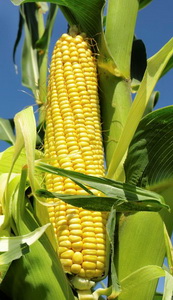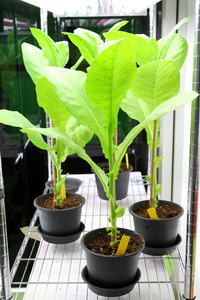 University of Wyoming (UW) scientist reports that herbicide use has increased more rapidly over the last 25 years in non-GE crops than in GE crops. The findings are published in Nature Communications.
University of Wyoming (UW) scientist reports that herbicide use has increased more rapidly over the last 25 years in non-GE crops than in GE crops. The findings are published in Nature Communications.CROP BIOTECH UPDATE
---------------------------------------------------------------------------
A weekly summary of world developments in agri-biotech for developing countries, produced by the Global Knowledge Center on Crop Biotechnology, International Service for the Acquisition of Agri-biotech Applications SEAsiaCenter (ISAAA)
---------------------------------------------------------------------------
April 19, 2017
In This Week’s Issue:
News
Global
Almost Two Billion People in the World Depend on Imported Food
Herbicide Use Increased More for Non-GM Crops than Biotech Crops, Study
Africa
Farms in Kenya Face Armyworms Attack
Americas
Abscisic Acid Role in Plant Branching
U.S. EPA Implements Temporary Exemption from the Requirement of a Tolerance for mCry51Aa2
UC Davis Scientists Report that Plant Genes Have Volume Controls
Lettuce Genome Assembly Published
Twitter Survey Shows 71% of Votes Say GMOs Needed to Feed World Population
Asia and the Pacific
Indonesian Farmers to Gain Access to Paddy Seeds Resistant to Hoppers and Bacterial Blights
Research
ES7 Functions in Nitrogen Metabolism and Chlorophyll Synthesis in Rice
Traditional Breeding Alters Maize Composition More than Stacking Transgenic Events
New Breeding Technologies
The Use of Viral Vectors for Plant Genome Editing
Tobacco Enzymes Inactivated via Multiplex CRISPR-Cas9 Strategy
Beyond Crop Biotech
Genetic Modification of Escherichia coli for Propionate Production
Announcements
International Food Conference on Global Food Security
----
NEWS
----
Global
ALMOST TWO BILLION PEOPLE IN THE WORLD DEPEND ON IMPORTED FOOD
Researchers at the Aalto University in Finland have, for the first time, shown a broad connection between resource scarcity, population pressure, and food imports. In a study published in the journal Earth's Future, the researchers found that even less wealthy regions relied on imports, but not always successfully. The food security of about 1.4 billion people has become dependent on imports and an additional 460 million people live in areas where increased imports are not enough to compensate for the lack of local production.
The researchers conducted a global analysis that focused on regions where water availability restricts production, and examined them from 1961 until 2009, evaluating the extent to which the growing population pressure was met by increasing food imports.
The work combined modelled data with FAO statistics and also took into consideration increases in production efficiency from technological development. The analysis showed that in 75% of resource scarce regions, food imports began to rise as the region's own production became insufficient. Keeping food demand in check is the key issue. Controlling population growth plays an essential role in this work, but it would also be important to enhance production chains by reducing food waste and meat consumption. Since one quarter of all the food produced in the world is wasted, reducing this would be really significant on a global level," said Dr. Joseph Guillaume, co-author of the study.
For more information, read the article at Aalto University News & Events, or read the open-access paper at Earth's Future.
 University of Wyoming (UW) scientist reports that herbicide use has increased more rapidly over the last 25 years in non-GE crops than in GE crops. The findings are published in Nature Communications.
University of Wyoming (UW) scientist reports that herbicide use has increased more rapidly over the last 25 years in non-GE crops than in GE crops. The findings are published in Nature Communications.
Herbicide use in farming GE crops has been a long time issue for biotech critics claiming that GE crop adoption increases herbicide usage. However, Andrew Kniss of the Department of Plant Sciences in UW showed that herbicide use intensity increased over the last 25 years in maize, cotton, rice, and wheat. Even if GM crops were perceived to cause an increase in herbicide use, the actual increases in herbicide use were faster in non-GM crops.
The results showed that even as herbicide use increased, chronic toxicity associated with herbicide use decreased in two out of six crops, while acute toxicity decreased in four out of six crops. In the last year of the study, glyphosate accounted for 26% of maize, 43% of soybean and 45% of cotton herbicide applications. However, due to the relatively low chronic toxicity of this particular herbicide, it contributed only 0.1, 0.3 and 3.5% of the chronic toxicity hazard in those crops, respectively.
If weeds are uncontrolled by herbicides, the global food production could decrease by 20-40%.
For more details, read the research article in Nature Communications.
Farmers from different areas of Kenya have reported infestation of armyworms, mostly attacking maize crops. Scientists are saying that genetic engineering could be the key solution to such attacks.
Armyworms are considered as deleterious pests because they usually occur in large populations causing havoc to vast areas of farms, which makes them difficult to control. Areas that have been reported to have infestations include Trans-Nzoia, Nakuru, Kakamega, Nandi, Busia, Bungoma, Uasin Gishu, Taita Taveta, and Kwale. This infestation is perceived to be related to the recent outbreaks in maize farms in Malawi, Zambia, and South Africa.
One type of armyworm, the fall armyworm, is considered to be more devastating than African armyworm because it feeds on the leaves, reproductive parts, silk, and the cobs. It is also more challenging to control because of possible resistance to insecticides. According to Prof. Paul Kimurto of Egerton University, there is a need for strong monitoring for outbreaks and use of Bt maize since armyworms are actually the caterpillar form of a species of moth, and are typically very vulnerable to the pesticides produced by GM maize.
Read more from All Africa.
Plant branching is a process regulated by phytohormones produced by the plant, similar to hormones found in animals. Many scientists have believed that auxin, the most intensely studied plant phytohormone, is the most important factor that controls branching. Researchers at Texas A&M University have found that abscisic acid (ABA), more known for its role in regulating water movement in plants, also plays an important role in plant branching.
Branching is controlled by light signals modified by neighboring plants. The stem grows taller if the branches are inhibited. The plant invests in the main shoot rather than in branching, to get to more direct light. The study examined plant mechanisms used to control branching in crowded and uncrowded conditions.
The researchers found that when given light signals that mimic crowded and uncrowded conditions, bud growth is altered very quickly, within six hours, when light signals are changed. They also found that changes in bud growth were more closely related to changes in ABA than auxin. ABA is one of the earliest regulators of branching. Auxin regulates from the stem, but ABA is present in the bud and is probably responding more directly to light signals that it receives.
For more details about this research, read the article at AgriLife Today.
The U.S. Environmental Protection Agency (EPA) announced temporary exemption from the requirement of a tolerance for residues of the Bacillus thuringiensis mCry51Aa2 protein in or on the food and feed commodities of cotton; cotton undelinted seed; cotton, gin byproducts; cotton, forage; cotton, hay; cotton, hulls; cotton, meal; and cotton, refined oil, when used as a plant-incorporated protectant (PIP) in accordance with the terms of Experimental Use Permit (EUP) No. 524-108. This regulation has been implemented in response to the petition of Monsanto for temporary tolerance exemption to eliminate the need to implement a maximum permissible level for residues of the Bt protein. The regulation is in place from April 18, 2017 to February 28, 2019.
Read the announcement in the U.S. Federal Register.
Researchers from the University of California, Davis reported that DNA sequences that were known to be vital for gene activity can be dispensable and the "junk DNA" or introns sometimes are in control. The results of their study are published in The Plant Cell.
UC Davis professor, Alan Rose, has been studying the mechanism known as "intron-mediated enhancement" for over 20 years. Rose and team made a significant discovery by studying Arabidopsis, which led them to the conclusion that introns play important roles in plants. They explained the role of introns using musical concepts.
"Imagine if music downloads were interrupted by blocks of white noise you had to manually edit out every time you played a song. Makes no sense, right? Why would songs be recorded that way? You can think of the DNA in your cells as a massive library of music. Genes are like songs that play at different volumes. The blocks of white noise are the introns."
For a long time, scientists have known that genes have an on/off switch the promoter. However, some genes that are consistently turned on might not have this switch. For such genes, the introns play as "volume control". The team plans to investigate more on how the process actually works and orchestrate a symphony of genes with important properties. Introns have already been used to enhance the gene activity for increased vitamin content in rice and higher yielding soybeans. They foresee that with more information about introns, they could be used to bump biofuels in algae, up insulin made by yeast, or even stimulate production of life-saving vaccines in tobacco.
Read more information from UC Davis.
Researchers from University of California, Davis (UC Davis) have released the first comprehensive genome assembly of lettuce and the huge Compositae plant family.
Garden lettuce (Lactuca sativa) includes a number of lettuce types, ranging from iceberg to romaine, is the most valuable fresh vegetable and one of the 10 most valuable crops, overall, in the United States. Lettuce is a member of the Compositae family, which includes the good, the bad, and the ugly of the plant world, from the daisy and sunflower to ragweed and the dreaded star thistle.
The research team found that specific genes in the lettuce genome were consistent with certain physical traits such as the production of a rubber-containing milky sap. This has also been found in taxonomically distinct species, such as the rubber tree. The study also found that somewhere during the evolution of lettuce about 45 million years ago, its genome was "triplicated." As a result, one-fourth of the genome appears in multiple related regions. As genomic duplications give plant species an advantage in colonizing new environments, the ancient triplication in lettuce might, in part, explain the success of the Compositae plant family.
For more details, read the article in the UC Davis Egghead.
 An on-going survey being conducted on Twitter by the Singularity Hub revealed that 71 percent of the respondents believe that genetically modified organisms (GMOs) are needed to feed the world population of 9.7 billion by 2050. Twenty-three (23) percent of the respondents, 1,338 in total as of writing, believe that there is a need to know more, while only 6 percent think that GMOs are too dangerous or unsafe.
An on-going survey being conducted on Twitter by the Singularity Hub revealed that 71 percent of the respondents believe that genetically modified organisms (GMOs) are needed to feed the world population of 9.7 billion by 2050. Twenty-three (23) percent of the respondents, 1,338 in total as of writing, believe that there is a need to know more, while only 6 percent think that GMOs are too dangerous or unsafe.
Singularity Hub chronicles technological progress by highlighting the breakthroughs, players, and issues shaping the future as well as supporting a global community of smart, passionate, action-oriented people who want to change the world.
For more, read their article The Future of Food: To GMO or Not To GMO?, or visit Singularity Hub.
Indonesian farmers may have access to paddy seeds resistant to hoppers and bacterial blights in the next few years, according to Syngenta Indonesia president director Parveen Kathuria. He said that a new product is under testing by the Agriculture Ministry, which might be commercially available in 2019.
"The Indonesian government is very stringent with regulatory requirements, on how much the production will bring new value. That's why it takes a lot of time to bring a new variety, especially in rice," Kathuria said. He discussed that Syngenta R&D teams have been working on developing resistance to leafhoppers and bacterial blights in the past six years. They will also produce rice-protecting herbicides in 2018.
Read the original article in The Jakarta Post. For more information about crops and products developed by Syngenta, visit their website.
Glutamate synthase (GOGAT) is a key enzyme for nitrogen metabolism and ammonium assimilation in plants. Recently, researchers from the China National Rice Research Institute identified and characterized an early senescence 7 (es7) rice mutant and aimed to characterize the function of the rice gene, ES7.
The leaves of the es7 mutant begin to senesce at the tillering stage, about 60 days after sowing, and become increasingly senescent as the plants develop at the heading stage. However, when es7 plants are grown under high CO2 conditions, the senescence phenotype and chlorophyll content are rescued. Analysis showed that senescence-associated genes were significantly upregulated in the es7 mutant.
Scientists then identified the ES7 gene, which encodes a ferredoxin-dependent glutamate synthase (Fd-GOGAT). ES7 is expressed constitutively, and its protein was localized in the chloroplast. Further analysis revealed that several genes related to nitrogen metabolism were differentially expressed while chlorophyll synthesis-associated genes were significantly downregulated in the mutant rice plant.
These results demonstrate that ES7 is involved in nitrogen metabolism and affects chlorophyll synthesis. It may also be associated with photorespiration, thus, affecting leaf senescence in rice.
For more on this study, read the article in Plant Science.
 Dow AgroSciences LLC researchers, led by Rod A. Herman, evaluated the impact of crossing (stacking) genetically modified (GM) events on maize grain biochemical composition and compared it with the impact caused by generating non-GM hybrids.
Dow AgroSciences LLC researchers, led by Rod A. Herman, evaluated the impact of crossing (stacking) genetically modified (GM) events on maize grain biochemical composition and compared it with the impact caused by generating non-GM hybrids.
The compositional similarity of seven GM stacks containing event DAS-ุ15ุ7-1 was compared to their corresponding non-GM near-isogenic hybrids (iso-hybrids) and to currently grown non-GM hybrids and their iso-hybrids. Scatter plots were used to visualize comparisons among hybrids.
The composition of GM breeding stacks was found to be more similar to the composition of their iso-hybrids than to the composition of non-GM hybrids to their iso-hybrids. Hence, non-GM breeding is more capable of influenced crop composition than transgenesis or stacking of GM events.
These findings can be grounds to call into question the importance of requiring composition studies for GM crops, especially for breeding stacks composed of GM events previously found to be compositionally similar to iso-hybrids.
For more on this study, read the article in Plant Biotechnology Journal.
Recent advances in genome engineering (GE) have made it possible to precisely alter DNA sequences in plant cells. However, its efficiency depends on the delivery method of both sequence-specific nucleases and repair templates. Typically, this is achieved using Agrobacterium-mediated transformation or particle bombardment, both of which transform only a subset of cells in treated tissues.
More efficient GE reagents delivery methods are clearly needed if GE is to become routine. Recently, autonomously replicating virus-based vectors have been demonstrated as efficient means of delivering GE reagents in plants. Both DNA viruses and RNA virus have demonstrated efficient gene targeting frequencies in model plants and crops.
Geminivirus vectors have recently been developed as promising tools to improve homology-directed repair in plants. However, there are still several issues needed to be addressed for improvement of this recent technique as regenerating plants transformed with geminivirus vectors has proven extremely difficult. Recently developed Tobacco rattle virus (TRV)-mediated CRISPR-Cas9 delivery system also has the potential to bypass the laborious and time-consuming tissue culture practices to develop plants with desirable engineered traits.
Syed Shan-e-Ali Zaidi and Shahid Mansoor from National Institute for Biotechnology and Genetic Engineering in Pakistan discussed the recent advances in using viral vectors for plant genome engineering, the current limitations, and future directions.
For more information, read the full article in Frontiers in Plant Science.
 Plants or plant cells can be used to produce pharmacological glycoproteins such as antibodies or vaccines. However, these proteins carry N-glycans with plant-typical residues, which greatly impact the effect or activity of the protein. Two enzymes are responsible for the addition of plant-specific glycans: β(1,2)-xylosyltransferase (XylT) and α(1,3)-fucosyltransferase (FucT).
Plants or plant cells can be used to produce pharmacological glycoproteins such as antibodies or vaccines. However, these proteins carry N-glycans with plant-typical residues, which greatly impact the effect or activity of the protein. Two enzymes are responsible for the addition of plant-specific glycans: β(1,2)-xylosyltransferase (XylT) and α(1,3)-fucosyltransferase (FucT).
A team of researchers led by S้bastien Mercx from Catholic University of Louvain aimed to knock-out two XylT genes and four FucT genes in Nicotiana tabacum BY-2 suspension cells using CRISPR-Cas9. Three XylT and six FucT sgRNAs were designed to target conserved regions. After transformation of N. tabacum BY-2 cells, genome-edited lines were obtained and their protein complements were analyzed.
Three lines showed a significant reduction in β(1,2)-xylose and α(1,3)-fucose, while two lines were completely devoid of them, indicating complete gene inactivation. The KO lines did not show any particular morphological changes and grew similarly as the wild types.
One KO line was then transformed with genes encoding a human IgG2 antibody. The IgG2 expression level was as high as in a control transformant which had not been edited.
For more information, read the article in Frontiers in Plant Science.
Propionate is used as an important preservative and important chemical intermediate for the synthesis of cellulose fibers, herbicides, perfumes, and pharmaceuticals. Biosynthetic propionate has mainly been produced by Propionibacterium, which has various limitations for industrial application.
Jing Li led a group of scientists from the Chinese Academy of Sciences and engineered Escherichia coli, combining a reduced TCA cycle with the native sleeping beauty mutase (Sbm) cycle to construct a fermentation pathway for anaerobic propionate production. The team overexpressed the Sbm operon in E. coli MG1655, yielding 0.24 g/L of propionate.
Genetic modification was also done to convert mixed fermentation products to succinate to increase precursors, thus, slightly increasing yield. Different types of promoters were also evaluated to maximize the Sbm operon. The constitutive promoter Pbba led to the highest titer of 2.34 g/L. Methylmalonyl CoA mutase from Methylobacterium extorquens AM1 was also added to strain T110 (pbba-Sbm) to enhance this process.
This study lays the groundwork for industrial propionate production using E. coli.
For more on this study, read the article in BMC Biotechnology.
What: 3rd International Food Conference on Global Food Security: Global Challenges, Local Solutions and Connected Pathways
Where: Cape Town, South Africa
When: December 3-6, 2017
For details on registration, programme, and submission of abstract, visit the conference website.